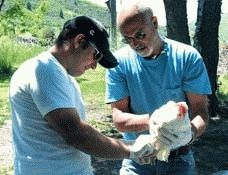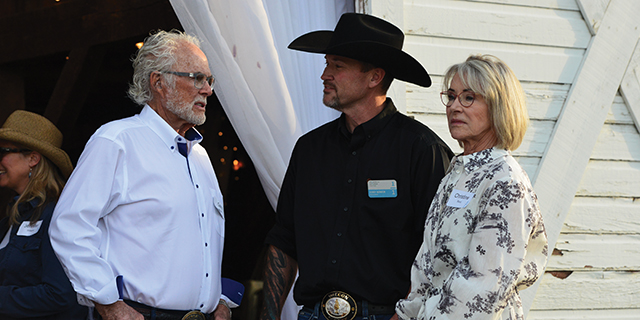KEEPING THE MOSQUITOES AT BAY
Published 12:00 am Wednesday, June 23, 2004

- CHICKEN DONATION: Kelly Beehler and Mike Craiger use a flock of six chickens to check whether they've contracted West Nile virus. Blood drawn regularly from the chickens is sent to a state health lab for testing. (The Observer/T.L. PETERSEN).
By T.L. Petersen
Staff Writer
There’s no question. Just spend an evening outside.
Mosquitoes are at large in Union County, and they are the mosquito variety known for carrying West Nile virus.
That’s the surprising conclusion of a mosquito-trapping program under way, thanks in part to voter approval in May of more funding for the county’s vector control district.
With voters’ approval of increased mosquito control funding, Vector District Coordinator Kelly Beehler has moved forward on many of his dreamed-of plans for keeping people and livestock safe, and mosquitoes under control.
"We now belong to the Oregon Vector Control Association," Beehler said from his tiny office in Bearco Loop last week. The office has a desk and a work table an improvement over the plywood sheet over two barrels in the back of a county garage that he formerly used as a work station.
On the table, Beehler is checking out the mosquitoes caught the night before in a trap in Island City.
It’s called a Vec test, and the result has been a surprise this morning.
Beehler expected to trap mostly a variety of "flood" mosquitoes, generally a harmless variety. Instead, almost all the mosquitoes trapped are of the variety that is known to carry the West Nile virus.
"This is the first time I’ve done this the Vec test it’s new this year," he explains as he counts out 50 female mosquitoes (the ones that bite).
The material needed to do Vec tests has been funded by a grant from the Oregon Health Department, Beehler said, and with funding for himself and a staff person now, the vector control district plans to do about 150 Vec tests this mosquito season.
The need for the tests became clear to Beehler when he learned in early June that a case of West Nile virus had been confirmed in a horse from Canyon County, Idaho, near Boise.
As of early June, the horse was doing fine and was expected to make a full recovery. The Idaho report, though, ended the question of how close West Nile had come to Eastern Oregon.
Back on his office table, Beehler counts 50 mosquitoes into a test tube, adds a metallic pellet, shakes the tube a bit to form a pulp of the insects, and inserts a test strip.
The Vec test strip operates like a home pregnancy test. If the mosquitoes are positive for West Nile, two blue lines appear on the strip. If not, only one blue line appears.
On the first Union County test, there’s just one blue line, which is good news.
Beehler and Mike Craiger load up the gear for the next test planned for the day. A pack, similar to a small car battery, attached by a curly cord to a large crayon-like black-and-green probe, is set up. The probe is first tested by dipping it into a fish bowl loaded with mosquito larvae in various stages of development.
Flip a switch, listen to a high-pitched squeak, and then note that all the swimming, jiggly larvae are now still.
"Got ’em," notes Craiger, eyeing the tank.
The larval sonic equipment just arrived over a week ago and is still being tested, Beehler says.
The equipment uses sound waves to kill mosquito larvae in water. No chemicals are involved, but Beehler and Craiger are still testing to determine how large an area the probe will affect.
The two take the probe system to an Island City backyard ornamental pond. Lots of bouncing mosquito larvae.
Beehler puts the probe in the water and hits the switch again.
He and Craiger kneel and peer into the water. The probe appears to have taken care of all the mosquito larvae.
Trying to kill adult mosquitoes, Beehler said, "is only about 5 percent of what we do."
That small percentage, he said, tends to be what people notice since it involves the application of the pesticide malathion.
"We treat larvae 95 percent of the time," he explains, and a natural bacteria control is used.
The species-specific bacteria is applied on tiny kernals of corn, for weight, which are then put into mosquito-favored water breeding sources.
"It’s very specific for mosquitoes," Beehler explains, "and it’s well-approved for aquatic use," safe for use around wildlife, waterfowl, fish, plants and domestic animals.
Because of people’s concern about malathion, Beehler is researching other possible pesticides to combat adult mosquitoes when needed. Malathion, he says, is used in much of human food, but there may be other chemicals, perhaps a chrysanthemum-derived chemical called pyrethrin, that might cause less public concern.
"What I do is as safe as possible," he assures. "I’ve just been looking at everything."
Back to local mosquito control.
With voters approving funding for the district, Beehler has been about to buy new larval-cide packs, which have made applying the pesticide more efficient and effective. Already, he said, he can see a drop in the use of the pesticide because the equipment works correctly.
And then there’s the chickens.
Veterinarian Dr. Mark Omann is keeping a half-dozen chickens at his property near Ladd Marsh.
Beehler and Craiger are becoming experts are catching each chicken, calming it, and then withdrawing tiny vials of blood from the fowl, using the tailgate of the district’s pickup as an examination table.
The vials are labeled, recorded and sent to Salem for testing for West Nile virus, which is known to show up in birds before appearing in mammals.
When not testing, Beehler and Craiger are continuing to map mosquito-prone areas in the county. Late spring rains this year have made more areas come to his attention.
"The flooding of the creeks this year," Beehler said, has increased the area for mosquito breeding. "It’s been real bad this year."





